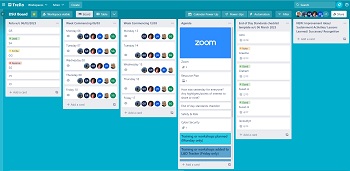Hybrid Daily Stand Ups
We first introduced Daily Stand Ups in our University in May 2013 and back then they were a new concept for everyone. The meetings were always held in person, with all participants standing round a board on a wall with paper documents that were updated using pens and pencils. They would gather together and follow a standard agenda and use the documents in front of them to discuss their plans for the day, raise improvement ideas, share lessons learned with each other and celebrate successes. It is true to say that over the years, these meetings have evolved, but over the past few years, they have evolved more than ever before.
The Move to Virtual Daily Stand-Ups
In March 2020 our own Daily Stand Up transitioned very quickly from being face to face one day, to completely online the next. It was thanks to the technology available to us at that time that enabled us to move from one format to the other (almost) seamlessly. We had obviously anticipated that a covid lockdown was on the cards, so we planned ahead. Some of the tools we used were new to us, some we had used for a while, but these actually meant that we could hold our Daily Stand Up meetings from the far flung corners of our kitchen tables and our makeshift desks, not face to face, but screen to screen. One thing that was crystal clear was that these meetings made people feel less isolated and added value to their day. Our blogs Staying connected through remote daily stand ups and The importance of wellbeing talk more about this.
 Holding the meetings over Zoom and using Trello felt a little bit odd at first, but very quickly we got used to them and found our way with the new situation we found ourselves in. We even had a new member of staff start in our team during this period and they were able to join in easily. We learned something new every day in that early period – many of our Lessons Learned were things we picked up about Zoom, so we shared them with each other and used them to continually improve our DSU meetings.
Holding the meetings over Zoom and using Trello felt a little bit odd at first, but very quickly we got used to them and found our way with the new situation we found ourselves in. We even had a new member of staff start in our team during this period and they were able to join in easily. We learned something new every day in that early period – many of our Lessons Learned were things we picked up about Zoom, so we shared them with each other and used them to continually improve our DSU meetings.
What remained the same through the transition from in person, to online was the basic structure, one that should be familiar across all DSUs. There is an agenda that is set for following, a resource plan, health and safety, a rota, and a continuous improvement section where improvement ideas, successes and lessons learned can all be raised. We have added to our DSU board – things like cyber security, an end of day checklist working & wellbeing checklist and a space for recognitions are a couple of the enhancements we have made. Fundamentally though, the structure, the backbone has remained.
Our meetings continued daily for the entire time that we were working from home. They were the same format as they had been, but we had made improvements over that period. We had learned new things about Trello and Zoom, we made tweaks and tried things out. We made incremental improvements as we went.
The Hybrid Evolution
Our most recent challenge was to come up with a way of running these meetings effectively when some participants are on campus and some working from home, to support our University’s approach to Hybrid (or Agile) working.
As a team, we agreed that it was not appropriate or indeed desirable to go back to how we did things pre-pandemic and have a board with paper documents. In many ways there was not too much to think about. There was very little to be done to our DSU to make it work for hybrid working. We had already proven to ourselves that the transition from working in the office to working from home had no negative impact on the effectiveness of our DSU, so moving to a hybrid was likely to be similar.
This has indeed been the case, both for our own DSU and others that we have helped evolve to a Hybrid model. It turns out that it doesn’t really matter where you are when you attend a DSU meeting. The only difference to being in the office means that you might need to use a set of headphones and put yourself on mute more regularly.
The key pillars for the success of a DSU are discipline and structure. You need to have the discipline to hold the meeting every day and the meeting should follow a structure. If you have these pillars in place, the DSU will work no matter where you are. The structure is such that the meeting translates into any setting. You can add to the structure to suit and to make the meetings work optimally for you.
If you would like to find out more about these meetings and how they can help you, get in touch with us at continuous-improvement@strath.ac.uk.


